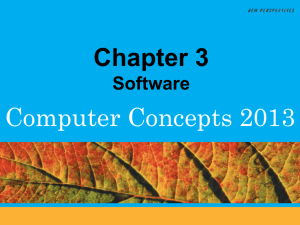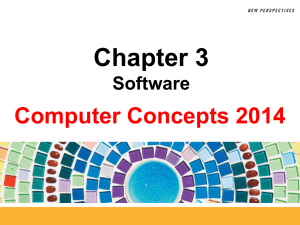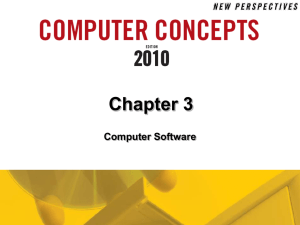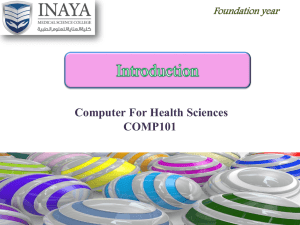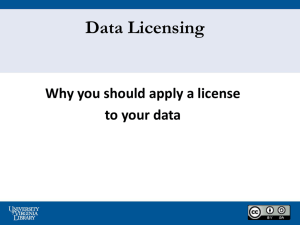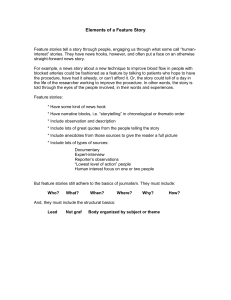Software
advertisement
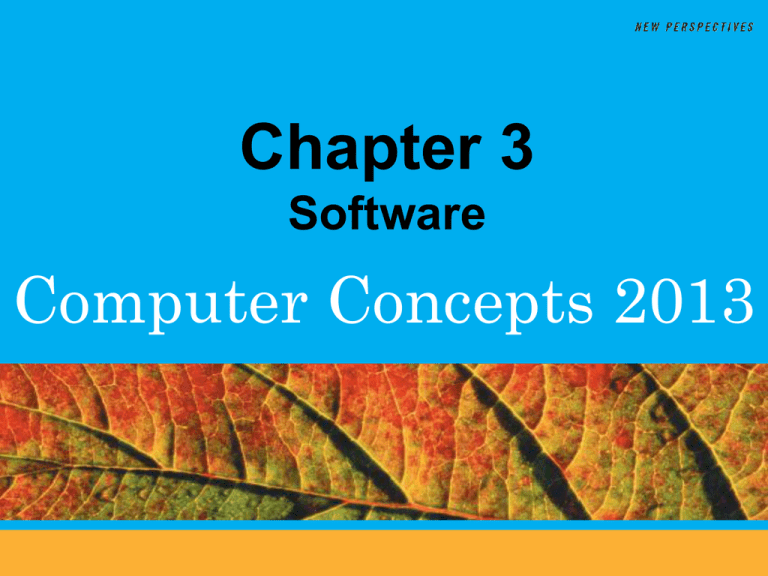
Chapter 3 Software Computer Concepts 2013 3 Software Categories Software is categorized in two main categories: Application software Designed to help people accomplish real-world tasks System software Designed for computer-centric tasks Chapter 3: Software 2 3 Music Software Offers many ways to work with music, sound effects, and narration from your desktop, notebook, or handheld computer iTunes Audio editing software Chapter 3: Software 3 3 Video Software Provides a set of tools for creating video productions from raw footage Consumer-level video editing software Windows Live Movie Maker Apple iMovie DVD authoring software Chapter 3: Software 4 3 Graphics Software Designed to help you create, manipulate, and print graphics Paint software Photo editing software Drawing software 3-D graphics software CAD software Chapter 3: Software 5 3 Mapping and Location-Based Software Chapter 3: Software 6 3 Business and “Number Crunching” Software Vertical market software is designed to automate specialized tasks in a specific market or business Horizontal market software is generic software that just about any kind of business can use Payroll software Accounting software Project management software Chapter 3: Software 7 3 Business and “Number Crunching” Software Provides a structured environment dedicated to a particular number crunching task Statistical software Mathematical modeling software Chapter 3: Software 8 3 Desktop Publishing Software CLICK TO START Chapter 3: Software 9 3 Personal Finance Software Chapter 3: Software 10 3 Utility Software Adaptive utilities alter a device’s user interface to create an accessible environment by providing closed captions, text-tospeech, speech-to-text, or large screen text System utilities that can track down and fix disk errors, repair corrupted files, and give your device a performanceenhancing tune-up Chapter 3: Software 11 3 Device Drivers Chapter 3: Software 12 3 Section B: Office Suites Office Suite Basics Word Processing Spreadsheets Databases Presentations Chapter 3: Software 13 3 Word Processing Chapter 3: Software 14 3 Word Processing Word processing features include: Word wrap Search and Replace Thesaurus Grammar checker Readability formula Spelling checker Spelling dictionary Chapter 3: Software 15 3 Word Processing CLICK TO START Chapter 3: Software 16 3 Word Processing CLICK TO START Chapter 3: Software 17 3 Spreadsheets A spreadsheet uses rows and columns of numbers to create a model or representation of a real solution Spreadsheet software, such as Microsoft Excel, iWork Numbers, Google Docs Spreadsheets, or LibreOffice Calc, provides tools to create electronic spreadsheets CLICK TO START Chapter 3: Software 18 3 Spreadsheets A formula tells the computer how to use the contents of cells in calculations Cell references Relative reference Absolute reference Mathematical operators Functions Automatic recalculations CLICK TO START Chapter 3: Software 19 3 Spreadsheets Chapter 3: Software 20 3 Spreadsheets CLICK TO START Chapter 3: Software 21 3 Databases A database is a collection of data Database software helps you enter, find, organize, update, and report information stored in a database Chapter 3: Software 22 3 Databases A query language such as SQL (Structured Query Language) provides a set of commands for locating and manipulating data Natural language query Keyword search Query by example Chapter 3: Software 23 3 Presentations Presentation software supplies the tools for combining text, photos, clip art, graphs, animations, and sound into a series of electronic slides that can be shown on a computer screen or projector CLICK TO START Chapter 3: Software 24 3 Web Apps CLICK TO START Chapter 3: Software 25 3 Mobile Apps Chapter 3: Software 26 3 Local Applications CLICK TO START Chapter 3: Software 27 3 Local Applications Chapter 3: Software 28 3 Local Applications Chapter 3: Software 29 3 Portable Software CLICK TO START Chapter 3: Software 30 3 Software Upgrades and Updates Periodically, software publishers replace older versions of a software product with a new version that’s sometimes referred to as a software upgrade A software update is a small section of program code that replaces part of the software you currently have installed Service packs Chapter 3: Software 31 3 Software Upgrades and Updates Updates are usually available online for registered software Automatic Update option Always install updates and service packs when they become available Many software publishers require users to type in a validation code to complete an upgrade CLICK TO START Chapter 3: Software 32 3 Uninstalling Software Uninstall routines delete the software’s files from the various folders on your computer’s hard disk CLICK TO START Chapter 3: Software 33 3 Consumer Basics Most operating systems include a handful of small applications and a good variety of useful utility software Chapter 3: Software 34 3 Consumer Basics System requirements specify the operating system and minimum hardware capacities necessary for a software product to work correctly Chapter 3: Software 35 3 Software Copyrights and Licenses A copyright is a form of legal protection that grants the author of an original “work” exclusive rights Copyright notice Software licenses, also called license agreements, define the ways in which you may use a computer program Single-user license Site license Multiple-user Concurrent-use license Shrink-wrap license Chapter 3: Software 36 3 Software Copyrights and Licenses EULA (End-User License Agreement) Different types of software licenses Public domain Proprietary Commercial software Demoware Shareware Open source BSD GPL Chapter 3: Software 37 3 Software Copyrights and Licenses CLICK TO START Chapter 3: Software 38 3 Software Copyrights and Licenses Freeware is copyrighted software that is available for free Product activation is a means of protecting software from illegal copying by requiring users to enter a product key or activation code before the software can be used A hash value is a unique number derived from encoding one or more data sets, such as names, serial numbers, and validation codes Chapter 3: Software 39 3 Security Software Basics Security software is designed to protect computers from various forms of destructive software and unauthorized intrusions The terms malicious software and malware refer to any computer program designed to surreptitiously enter a computer, gain unauthorized access to data, or disrupt normal processing operations Chapter 3: Software 40 3 Security Software Basics Computer virus Computer worm Mass-mailing worm Trojan horse Remote Access Trojan (RAT) Bot Spider Botnet Spyware Chapter 3: Software 41 3 Security Software Basics Chapter 3: Software 42 3 Security Software Basics The term rootkit refers to software tools used to conceal malware and backdoors that have been installed on a victim’s computer A virus hoax usually arrives as an email message containing dire warnings about a supposedly new virus on the loose Chapter 3: Software 43 3 Security Suites CLICK TO START Chapter 3: Software 44 3 Antivirus Modules Chapter 3: Software 45 3 Antivirus Modules Most experts recommend that you configure your antivirus software to periodically scan all the files on your computer If, during the scanning process, your virus protection software identifies a virus, worm, Trojan horse, or bot in a file or attachment, it can try to remove the infection, put the file into quarantine, or simply delete the file Chapter 3: Software 46 Chapter 3 Complete Computer Concepts 2013
